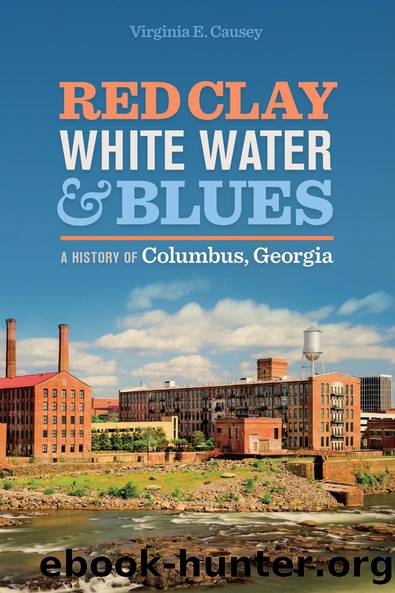Red Clay, White Water, and Blues by Virginia Causey

Author:Virginia Causey [Causey, Virginia]
Language: eng
Format: epub
Tags: History, United States, State & Local, South (AL; AR; FL; GA; KY; LA; MS; NC; SC; TN; VA; WV)
ISBN: 9780820355030
Google: tq2aDwAAQBAJ
Publisher: University of Georgia Press
Published: 2019-05-15T00:46:39+00:00
In the wake of the success of bus boycotts in Montgomery, Alabama, and elsewhere, Columbus activists turned their attention to the cityâs bus system. The local ordinance said drivers could âassignâ seats, and âno passenger shall remain in any car, compartment, or seat other than that to which he has been assigned.â Drivers had the power to eject un-cooperative riders. On Christmas Eve 1956, four days after the U.S. Supreme Court upheld a lower court ruling requiring Montgomeryâs buses to integrate, police arrested a Negro soldier for sitting in the front of a Columbus bus. Five months later, another black soldier faced charges for violating the bus ordinance. On June 2, 1961, Freedom Riders passed through Columbus, with black and white students sitting together in the Greyhound terminal without incident. Shortly thereafter, the local Black Ministerial Alliance petitioned the city commission to integrate Columbusâs buses, to no effect. Early in July, under federal pressure, the county commission desegregated the Columbus airport, where segregated waiting rooms had offended âcoloredâ military officers from Latin American countries receiving training at Fort Benning. At around the same time, local activists renewed their assault on bus segregation. Columbus native Rudy Allen had been attending the American Baptist Seminary in Nashville, where he and classmates John Lewis and James Bevel had participated in the nonviolent sit-ins that eliminated segregation at lunch counters. Allen wanted âto get something startedâ in Columbus and requested help from students. A Student Non-Violent Coordinating Committee representative conducted a workshop at the Ninth Street YMCA, but many young people objected to the idea that they would have to endure being spit on or slapped without retaliating, and the group shrank to about a half dozen.18
On July 17, representatives of the Non-Partisan Voters League again requested the integration of the buses. When the mayor brushed off the request, a League spokesman warned that a âgroup of impatient citizensâ would be riding the buses that afternoon. One hour later, black students were sitting in the front of three city buses. Bunky McClung, whose father, A. J., directed the YMCA, opened a book to appear relaxed but was so nervous that she did not realize she was holding the book upside down. The bus driver ordered McClung and the three other activists to the back of the bus, but they did not respond. The driver called the police, and within minutes the four found themselves under arrest. Two other protesters on another bus were also arrested, but the police did not detain Allen and his partner on a third bus. At the old stockade, the police separated the arrested students, questioning them repeatedly on the assumption that they were âoutside agitators.â Albert Thompson, the only black attorney in town, bailed them out. The adult leaders, including Thompson, A. J. McClung, and NAACP president George Ford, wanted to sue to desegregate the bus line, but Allen believed a lawsuit would take too long. On August 4, he and the students again rode the buses. Police arrested all riders, charging them with disorderly conduct.
Download
This site does not store any files on its server. We only index and link to content provided by other sites. Please contact the content providers to delete copyright contents if any and email us, we'll remove relevant links or contents immediately.
| Americas | African Americans |
| Civil War | Colonial Period |
| Immigrants | Revolution & Founding |
| State & Local |
In Cold Blood by Truman Capote(3306)
The Innovators: How a Group of Hackers, Geniuses, and Geeks Created the Digital Revolution by Walter Isaacson(2832)
Steve Jobs by Walter Isaacson(2831)
All the President's Men by Carl Bernstein & Bob Woodward(2326)
Lonely Planet New York City by Lonely Planet(2170)
And the Band Played On by Randy Shilts(2127)
The Room Where It Happened by John Bolton;(2102)
The Poisoner's Handbook by Deborah Blum(2089)
The Murder of Marilyn Monroe by Jay Margolis(2057)
The Innovators by Walter Isaacson(2055)
Lincoln by David Herbert Donald(1943)
A Colony in a Nation by Chris Hayes(1880)
Under the Banner of Heaven: A Story of Violent Faith by Jon Krakauer(1746)
Amelia Earhart by Doris L. Rich(1647)
The Unsettlers by Mark Sundeen(1642)
Birdmen by Lawrence Goldstone(1618)
Being George Washington by Beck Glenn(1611)
Dirt by Bill Buford(1610)
Zeitoun by Dave Eggers(1589)
